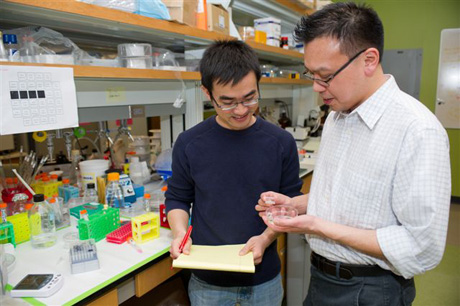Biomedical engineer and pediatric hematologist/oncologist Wilbur Lam, has earned a Faculty Early Career Development (CAREER) award from the National Science Foundation. The four-year, $450,000 award will support Lam's research on the biomechanical properties of platelets, the cells responsible for blood clot formation.
Lam is an assistant professor in the Wallace H. Coulter Department of Biomedical Engineering at Georgia Tech and Emory University and in the Division of Hematology/Oncology within Emory's Department of Pediatrics. He sees patients at the Aflac Cancer and Blood Disorders Center at Children's Healthcare of Atlanta.
Anticoagulants, or blood thinners, are prescribed to millions to reduce the risk of heart attack or stroke. Lam's research focuses on platelet biophysics and how platelets contract at the single cell level. This could lead to new categories of platelet diagnostics and help scientists identify new types of blood thinning drugs, which would modify how stiff platelets are or how they contract. A better understanding of platelets' properties could also inform treatment of other diseases such as inflammatory disorders, sickle cell anemia, and infections.
Lam has developed a technology allowing measurement of the forces generated by individual platelets as they contract. In a paper published in the journal Nature Materials, he and colleagues isolated single platelets, which were made fluorescent with dye, in a customized atomic force microscope. With the CAREER award, he plans to refine the technology to permit the examination of thousands of platelets at once on a microchip using technology adapted from the computer chip industry.
"What's exciting about this area of research is that it could open up a whole new category of potential diagnostics and therapies,” Lam says. "A blood clot is ultimately a physical entity, in that the platelets have to stitch a wound together and stop blood from flowing. We were able to show that platelets contract, acting somewhat like muscle cells, when they come into contact with a developing clot, and that they are able to 'sense' the local physical properties of the clot to adjust their force of contraction functioning like a finely tuned 'nanomachine'.”
NSF CAREER awards go to investigators in the early stages of their careers as they work on transformative ideas in their fields while also striving to educate the next generation of scientists. As part of his project and as a pediatrician who cares for children with cancer and chronic blood diseases, Lam plans to develop a K-12 science outreach program for hospitalized children, in which the children's own diseases are used as springboards for learning about science. The program will enable undergraduate, graduate and medical students to develop age-appropriate biology, physics, chemistry and mathematics modules centered around chronic diseases for which children at Children's Healthcare of Atlanta are hospitalized.
"Children who have chronic illnesses often miss large amounts of school, and they have concrete educational disadvantages as a result,” Lam says. "We want to use their natural interest in their own bodies as a way to introduce basic scientific and mathematic concepts that will hopefully inspire them to learn more and to actually use their diseases to their advantage.”

